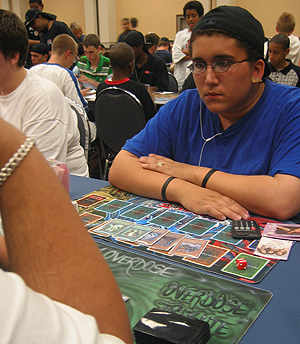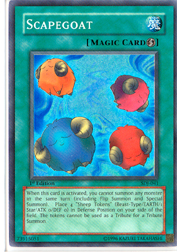
One of my close friends said to me this past weekend, “The scariest players are those without fear.” Fear, he explained, is what prevents most of the reckless plays that can lead to either amazing comeback victories or shameful defeats. He claimed that when a player did not summon Cyber-Stein, special summon Cyber Twin Dragon and attempt to attack for game despite three facedown traps, he or she was both afraid to be stopped and worried about being called on such nuttiness. This led me to view the game quite differently.
If one attempts to end a game in such a “fearless” fashion, is he or she a bad player? Definitely not. A risk-taker? Quite. Most people don’t go all-out for the win unless they’re somewhat certain it will work. Not only is it disappointing when your opponent has the answer to your “recklessness,” but it’s also quite embarrassing. For a long time it’s been widely considered foolish to spend the best cards in your hand on a possible game shot unless you’re either certain it will go through, or against the ropes with no other move. Take for example, Shane Scurry’s match against Chris Winkler at Shonen Jump Baltimore. Here, Shane held on to his Heavy Storm/Return from the Different Dimension as long as possible before finally committing to a one-turn-kill-or-bust strategy. In this instance, it paid off, and Scurry moved on to the finals. Had it not, Scurry would have been deemed an “unlucky player” who “had no other option.” Had he gone for his Return shot earlier in the game, he would have been criticized for being overzealous.
There are plenty of situations where going for game seems like a risky move, and biding time until you’re more certain is a better choice. However, I’d be lying if I told you that being too conservative has never turned around to kick me in the rear. Giving yourself more turns to build up an offense gives your opponent the same amount of turns to build up a defense. The sooner you make a risky move, the less likely your opponent is to have the answer.
Which brings me to this weeks’ champion. Cesar Gonzalez is undoubtedly a man without fear. It takes some serious guts to walk into a 10 round Shonen Jump armed with three Cyber-Stein cards in the main deck . . . especially when your deck isn’t 100% devoted to a one-turn kill combo.
Monsters: 22
3 Cyber Dragon
3 Cyber-Stein
3 Dekoichi the Battlechanted Locomotive
3 Nimble Momonga
2 Magician of Faith
2 Spirit Reaper
1 Night Assailant
1 Tsukuyomi
1 D. D. Warrior Lady
1 Sangan
1 Treeborn Frog
1 Breaker the Magical Warrior
Spells: 15
3 Megamorph
2 Nobleman of Crossout
3 Giant Trunade
1 Mystical Space Typhoon
1 Graceful Charity
1 Heavy Storm
1 Limiter Removal
1 Book of Moon
1 Snatch Steal
1 Scapegoat
Traps: 4
2 Sakuretsu Armor
1 Torrential Tribute
1 Mirror Force
Side:
2 Royal Decree
2 Return from the Different Dimension
1 Call of the Haunted
1 Confiscation
1 Premature Burial
3 Chaos Sorcerer
2 Magical Merchant
2 Zaborg the Thunder Monarch
1 Mobius the Frost Monarch
 As you can see, this deck needs to be piloted by a fearless captain. In Cesar’s main deck, we see all the components of a regular Cyber-Stein OTK. Three copies each of Cyber-Stein, Megamorph, Giant Trunade, Nimble Momonga, and one copy of Limiter Removal, are the staple combo pieces for the OTK. However, that’s pretty much where the deck jumps the rails from its OTK strategy.
As you can see, this deck needs to be piloted by a fearless captain. In Cesar’s main deck, we see all the components of a regular Cyber-Stein OTK. Three copies each of Cyber-Stein, Megamorph, Giant Trunade, Nimble Momonga, and one copy of Limiter Removal, are the staple combo pieces for the OTK. However, that’s pretty much where the deck jumps the rails from its OTK strategy.
It then combines the Machine aspects of your traditional Chaos/Return deck. Three copies each of Cyber Dragon and Dekoichi the Battlechanted Locomotive make for some nice field presence and fast attacks. Dekoichi also helps accelerate your draws to increase the chance of drawing into an OTK, while also acting as a neat 1400 beat stick.
A pair of Spirit Reaper cards seems odd for the deck at first glance. This deck doesn’t really need to slice cards with Reaper that soon. In fact, doing so can put Cesar into situations where his vulnerable Reaper causes his life points to drop below 5000. That’s very bad, since Cesar likely wins a fair amount of his games on the OTK with Cyber-Stein. However, Cesar’s deck can pull wins out without needing Cyber-Stein. In those instances, Spirit Reaper becomes much less of a liability. In addition, a defense-mode Spirit Reaper is excellent for stalling a few turns to draw out that last piece of the game-winning combo.
The remaining monsters are there for utility purposes. Magician of Faith and Night Assailant can be abused with Graceful Charity and Tsukuyomi, while being generally acceptable cards on their own. Each can help fuel the OTK combo, or act as a nuisance to your opponent. D. D. Warrior Lady and Tsukuyomi are also utility monsters, whose effects are situational game-breakers, and otherwise acceptable. Sangan is always a no-brainer, and Treeborn Frog helps put up a wall of defense to keep Cesar’s life above 5000.
 OTK pieces aside, Cesar’s spells aren’t all that awe-inspiring. He’s got the essentials and another utility card in the form of Book of Moon. Scapegoat is a bit controversial in this deck, since it can clog up Cesar’s field and provide an exceptionally difficult scenario in which to pull out a win. However, in a format where Spirit Reaper, Return from the Different Dimension, and a random copy of Cyber-Stein are floating around in about every deck list, Scapegoat will likely save more games than it loses.
OTK pieces aside, Cesar’s spells aren’t all that awe-inspiring. He’s got the essentials and another utility card in the form of Book of Moon. Scapegoat is a bit controversial in this deck, since it can clog up Cesar’s field and provide an exceptionally difficult scenario in which to pull out a win. However, in a format where Spirit Reaper, Return from the Different Dimension, and a random copy of Cyber-Stein are floating around in about every deck list, Scapegoat will likely save more games than it loses.
The trap line-up for Cesar consists only of 4 defensive traps, which means he can be put on the ropes quite easily if he draws into extra OTK pieces that don’t do much else. Thus, he needs to be able to defend himself. Defensive traps also protect Dekoichi from being destroyed before it can wreak havoc on the opponent’s life points. A copy of Swords of Revealing Light does the same thing, however, and I would likely try to work one into the deck.
You’ll notice that I’ve included the side deck here this week. That’s because Cesar likely used his side deck every single match. The entire 15 cards are mainstream Chaos/Return cards. Yup, you guessed it; Cesar actually side decks into the Chaos/Return deck that everyone else plays with game 1! What does he accomplish by doing this? First, his opponent is likely to side in Kuriboh or Waboku cards, all of which are weak in a Chaos/Return mirror match. Secondly, once your opponents know they have to punch your life below 5000, they’ll try to do so as fast as possible. If they get too aggressive, a Chaos/Return deck will punish them a lot more than your standard Stein OTK. Finally, Chaos/Return offers a much more consistent draw. While Cesar often won the first game of his matches with Cyber-Stein, he would rarely opt to push his luck, instead finishing off the match with Chaos.
Chaos/Return also works better against those awkward rogue decks. If you find yourself up against a Spell Canceller deck (or something else wacky), your Machine build will be quite vulnerable to cards nobody plans on seeing. Chaos/Return has by far the best arsenal to take down rogue decks, and using that to your advantage will help the Machines pull out wins they would otherwise be very hard-pressed to earn.
On the flip side, there are also rogue matches where Stein OTK is exactly the deck you want. Against Clock Tower Control, for example, being able to finish the game within the first few turns is perfect. Having three copies of Giant Trunade in the main deck is also a nasty surprise for the Clock Tower player. PACMAN can find the same problem with the extra spell/trap removal cards.
Between the main deck and the side deck, this build has everything. Consistent, a fearless OTK, and anti-rogue on both ends of the spectrum, it makes a solid pick for any Shonen Jump tournament. Cesar’s top 8 finish is not shocking in the slightest, and I expect this to be the deck to beat at Shonen Jump Indianapolis this year.